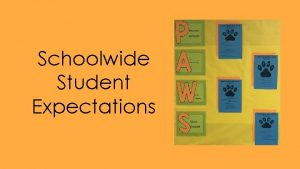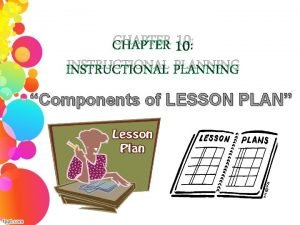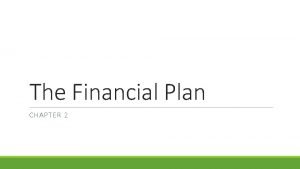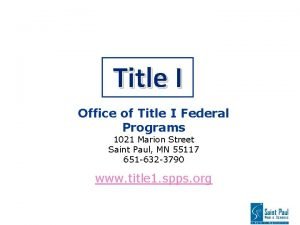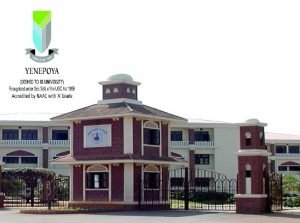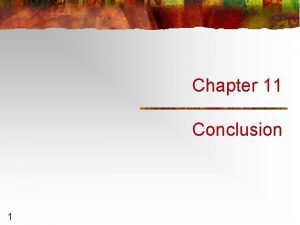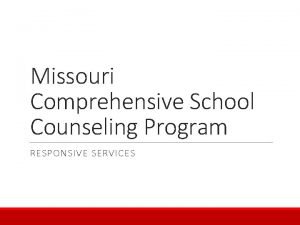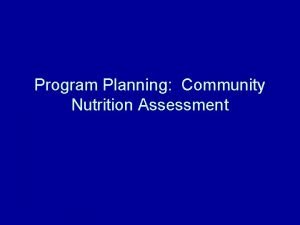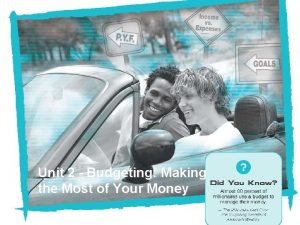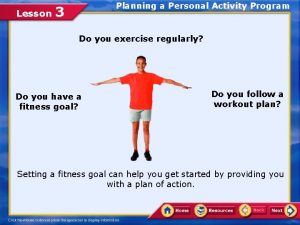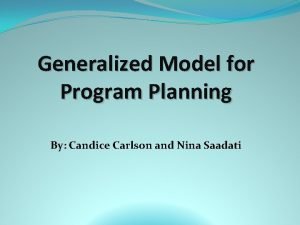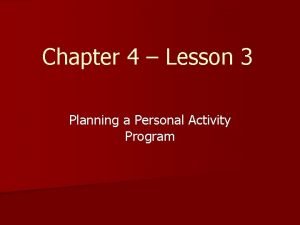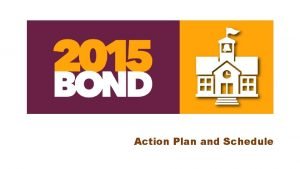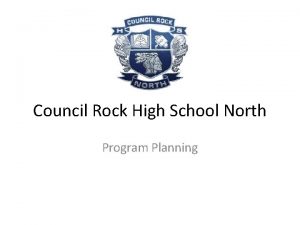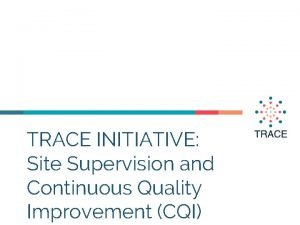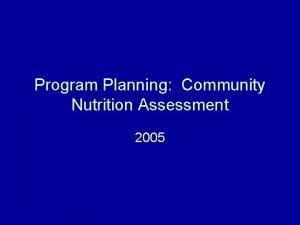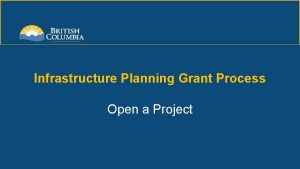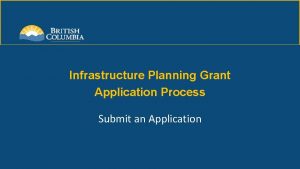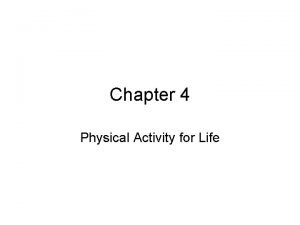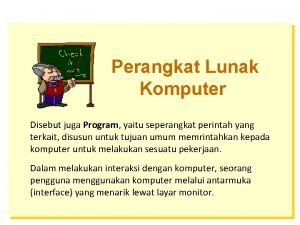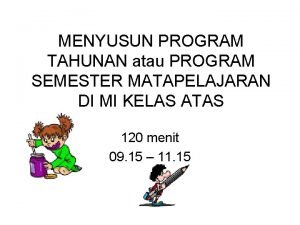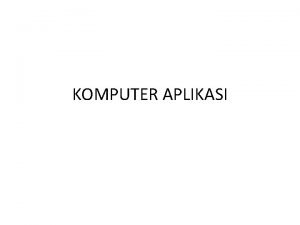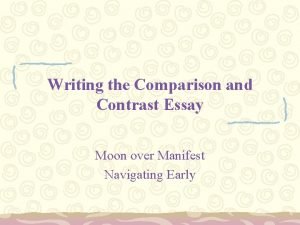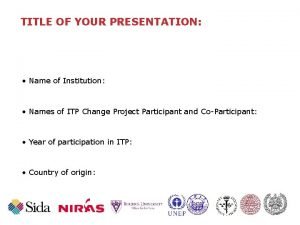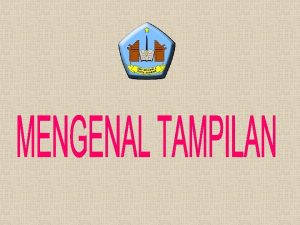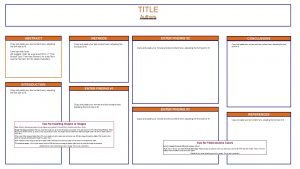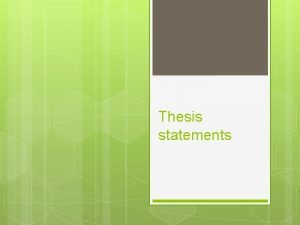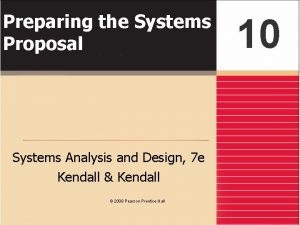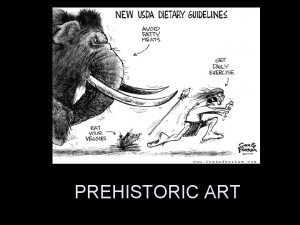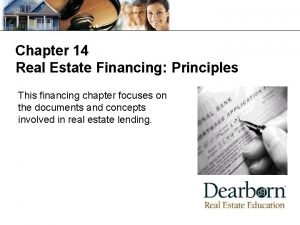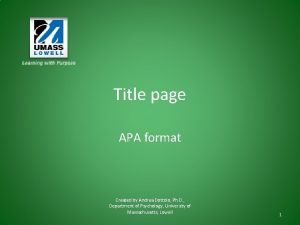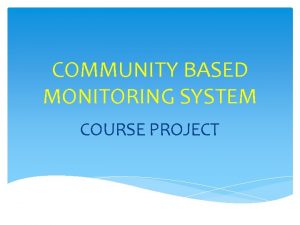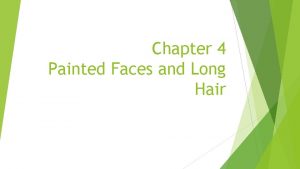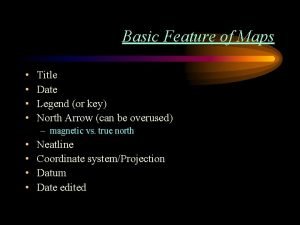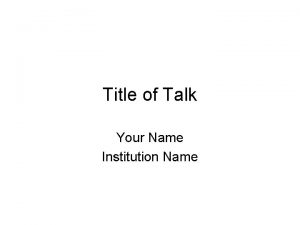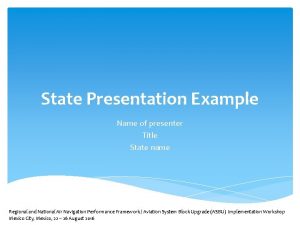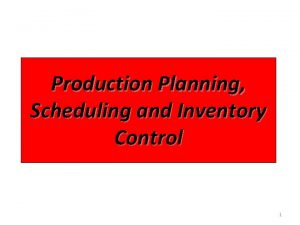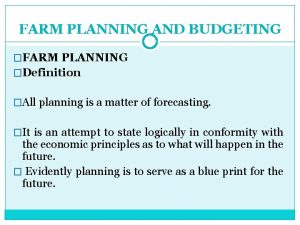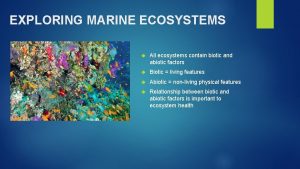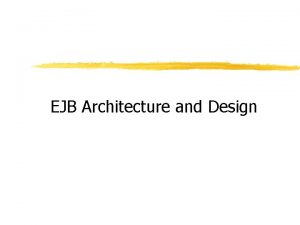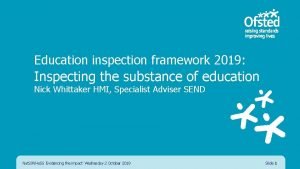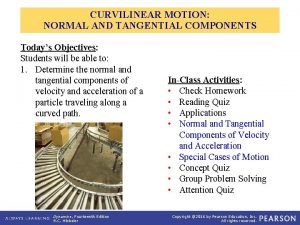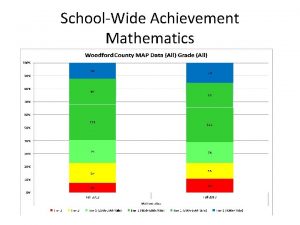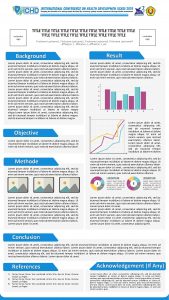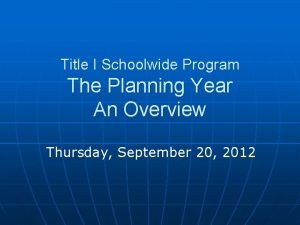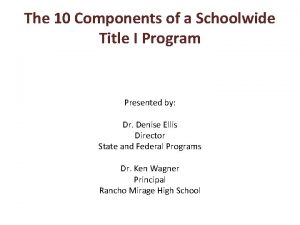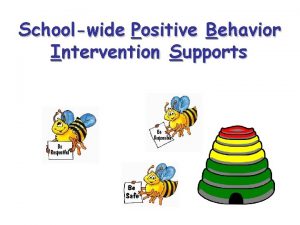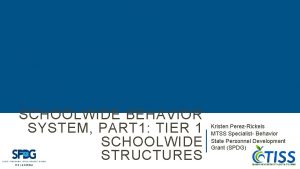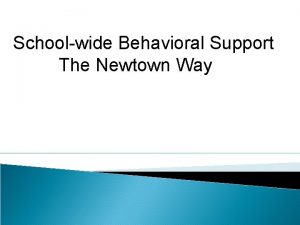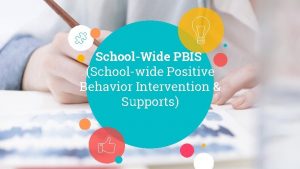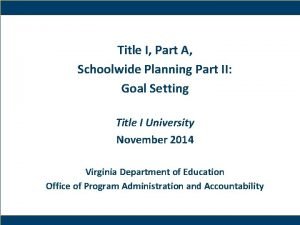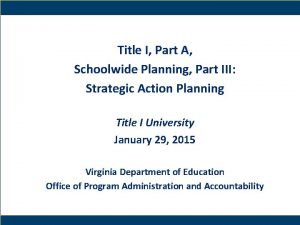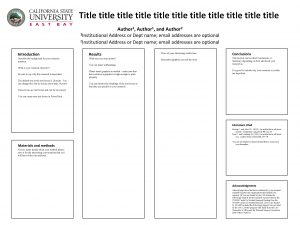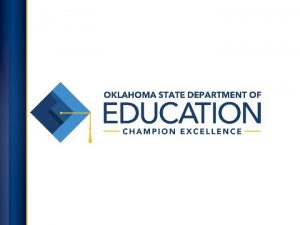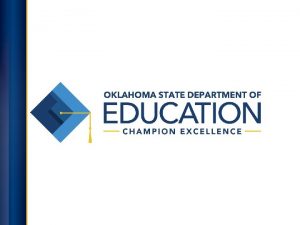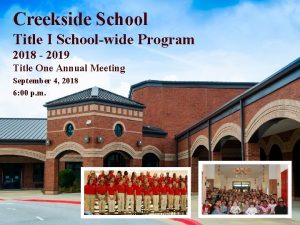Title I Schoolwide Planning Schoolwide Program Components and















































































- Slides: 79

Title I Schoolwide Planning Schoolwide Program Components and WISE Tool Indicators Wednesday, November 28, 2012

Objectives for Today n n n Review the ten schoolwide program components. Review the 17 Key WISE Tool indicators that will form the framework for your schoolwide plan. Connect the comprehensive needs assessment, the ten program components and the 17 Key WISE Tool indicators. 2

Schoolwide Planning Team Corina Ene Program Specialist Titles I, II, VI, and X, OSDE Vickie Stewart Program Specialist Titles I, II, VI, and X, OSDE Lois Howard Director, School Support, Bartlesville Public Schools Jo. Anne Graham Coordinator, School Support, Ardmore City Schools 3

Review n n A schoolwide program is a comprehensive reform strategy designed to upgrade the entire educational program of a Title I school. The emphasis of a schoolwide program is on serving all students, improving all structures and combining all resources, to achieve a common goal – Improving Student Learning. 4

Review n A schoolwide program is made up of three core elements: 1. Comprehensive needs assessment 2. Written schoolwide plan 3. Annual review and plan update n A schoolwide plan must address ten program components. 5

Ten Schoolwide Program Components 6

Comprehensive Data Driven Needs Assessment of the Entire School 1114. Schoolwide Programs (b)(1)(A) NCLB 2001 A comprehensive needs assessment is an organized process for identifying, gathering, synthesizing and analyzing information into data that can be used to make informed decisions. 7

Needs Assessment n Data that must be reviewed • Individual student achievement data • OCCT and EOI data • Student progress data showing growth toward meeting the state’s C 3, CCSS and ACE standards n Other data to review • Student and teacher demographics • School climate data • Student, teacher and parent surveys 8

Needs Assessment n Planning Team must develop a system for: • Identifying data • Analyzing data • Using data • Regularly up-dating data n Needs assessment is an on-going process not a one-time event. 9

Schoolwide Reform Strategies 1114. Schoolwide Programs (b)(1)(B) NCLB 2001 n Strategies selected must: • Provide opportunities for ALL students to meet the state highest academic standards. • Use effective methods supported by scientifically based research • Include support for low-achieving and at -risk students 10

Reform Strategies n Effective methods are those that: • Strengthen and add rigor to core academic subjects. • Increase the amount and quality of learning time. • Target basic services for all students, including low achieving, advanced, homeless and ELL students and students with disabilities. • Are consistent with State and Local school improvement goals 11

Reform Strategies n Strategies for increasing learning time include: • Extended school day • Extended school year • Before and after school classes • Summer classes • Embedded enriched curriculum • Accelerated curriculum 12

Reform Strategies n Basic student needs include: • Counseling and mentoring services • Survival and social services • College and career guidance • Personal financial classes • Applied learning projects • Team teaching • Vocational and technical training • School breakfast and lunch program • Language interpreters 13

Instruction by Highly Qualified Teachers 1114. Schoolwide Programs (b)(1)(C) NCLB 2001 n n n Every student taught by teachers who are licensed and certified to teach in Oklahoma. Every teacher certified to teach the grade or subject assigned. Teachers must be knowledgeable of the content taught and use best practice methodologies. 14

Instruction by Highly Qualified Teachers n n Teachers must be skilled in classroom management and parent communications Plan professional development so that teachers are in the classroom Teachers should have high attendance and limited tardies. Teacher evaluation system should encourage growth 15

Recruit and Retain Highly Qualified Teachers 1114. Schoolwide Programs (b)(1)(E) NCLB 2001 n n Teachers are hired to reflect the demographics of the students. Anticipate staffing needs • Recruit and hire early • Train committed teachers for hard to fill positions n Recruit experienced, effective teachers to work with lowest achieving students. 16

High-Quality, Ongoing, Embedded Professional Development 1114. Schoolwide Programs (b)(1)(D) NCLB 2001 n n n Professional development should focus on preparing teachers, principals and paraprofessionals to help ALL students meet Oklahoma’s academic standards. Professional development should be driven by student learning gaps. Professional development should be narrowly focused and monitored. 17

Increase Parent and Family Involvement 1114. Schoolwide Programs (b)(1)(F) NCLB 2001 n n School programs, activities and procedures should be planned and implemented with meaningful consultation with parents. School must have a parent involvement policy and a parent compact developed with parent consultation. 18

Increase Parent and Family Involvement n n n School must hold an annual parent information meeting to explain Title I program. School must implement an on-going parent and family communication system. School must honor “Parents Right-To -Know” requirements. 19

Increase Parent and Family Involvement n n School may encourage and support parents so they can participate more fully in the education of their children. School may provide a resource center for parents. 20

Include Teachers in Assessment and Instructional Decisions 1114. Schoolwide Programs (b)(1)(H) NCLB 2001 n n Teachers should receive training in using data to make informed decisions. Teachers should be involved in making data driven decisions about: • The selection of instructional materials. • The selection, interpretation and use of student assessments. • Professional development to improve student instruction. 21

Plan for Successful Student Transitions 1114. Schoolwide Programs (b)(1)(G) NCLB 2001 n n Assistance for parents and preschool children in transitioning from early childhood programs to elementary school. Assistance for parents and students any time there is a transition from a familiar to a new situation (from one grade to the next; from one building to another). 22

Effective and Timely Additional Assistance for Students 1114. Schoolwide Programs (b)(1)(I) NCLB 2001 n n n Activities must be in place to ensure that students who have difficulty mastering state standards receive additional assistance. Timely identification using effective diagnostic methodologies. Timely, prescriptive interventions to help students master deficient standards. 23

Coordination of Federal, State and Local Resources 1114. Schoolwide Programs (b)(1)(J) NCLB 2001 n Local, state and federal resources should be scaffold to ensure that all students receive equitable instruction, instructional materials, services and when appropriate increased learning opportunities. 24


26

17 Key Indicators 27

Components and Indicators 28


WISE Tool Account n n Each school site will need its own account Each district will need a linked account To request an account, send an Email to Corina Ene Corina. Ene@sde. ok. gov Help! Do not call Indistar. Send E-mail to Iva Owens – Iva. Owens@sde. ok. gov 30

http: //www. centerii. org/School. Restructuring/login. aspx 31

32

33

34

35

36

37

38

39

40

41

42

43

44

45

46

Level of Implementation of Indicator n n A. No Development - Not a Priority/ Interest (Not an Option for Schoolwide Plan) B. No Development - Will Include in plan C. Limited Development D. Full Implementation. 47

Required. Must be included in Schoolwide Plan. Do Not Mark “A” 48

Site data from needs assessment. Use wording from Wise Ways and Rubric to develop statement. “What does our school look like today? ” 49

If you check “D” you cannot add action steps. If you check “D” you cannot go back and edit. . 50

51

52

53

54

55


57

58

59

60

61

62

63

64

65

66

67

68


Where Are We Check-Up 70

Steps Completed n n Schoolwide planning notebook started “Intent to Establish Title I Schoolwide Program” form and Title I Schoolwide Program Assurances uploaded to file cabinet. Technical assistance provider identified. Resolution from site Title I Committee documented. 71

Steps Completed n n Parent informational meeting documented. Staff informational meeting documented. Have in place a structure and timeline for developing your Title I schoolwide plan. Core schoolwide planning team is in place and functioning. 72

Steps Completed n n Established a WISE Tool account and have completed steps 1, 2 and 3. Completed a written vision of what you want your Title I schoolwide school to look and sound like. Completed needs assessment. Reviewed the 9 Essential Elements. 73

Things To Do Next n n Review Rubric and Wise Ways for each Key Indicator. Assess 17 Key Indicators: • Level of implementation for each indicator • Assign Priority Score • Assign Opportunity Score n Describe level of current implementation for each indicator 74

Resources Title I Schoolwide Program 75

Resource OSDE Website - sde. state. ok. us http: //ok. gov/sde/title-i-part#Schoolwide Designing Schoolwide Programs Non Regulatory Guidance March 2006 http: //ok. gov/sde/sites/ok. gov. sde/files/Fed. Prog. Title. I-Designing. Programs. pdf Nine Essential Elements http: //ok. gov/sde/sites/ok. gov. sde/files/WISEPerf. Indicators. pdf 76

Videoconferences Setting Schoolwide Goals and Creating WISE Tasks Thursday, January 17, 2013 Completing Your Schoolwide Planning Year Wednesday, February 20, 2013 77

Due Date New Schoolwide Plans For Implementation August 2013 Friday, May 31, 2013 Completed Plan Submitted On-line Using the WISE Tool 78

Technical Assistance Corina Ene Program Specialist 405 -522 -1929 Corina. Ene@sde. ok. gov Your Assigned Title I Program Specialist Lois Howard Phone: 918 -335 -2931 Howard. L@bps-ok. org Jo. Anne Graham Phone: 580 -221 -3001 X 132 joanne@ardmore. k 12. ok. us 79
 Schoolwide expectations
Schoolwide expectations Prefatory and supplementary part of proposal
Prefatory and supplementary part of proposal Title title
Title title N planning
N planning Short, medium and long term planning in education
Short, medium and long term planning in education What is language planning
What is language planning Components of instructional planning
Components of instructional planning What are the 7 key components of financial planning
What are the 7 key components of financial planning Poc project adalah
Poc project adalah Title one program
Title one program Reproductive and child health programme definition
Reproductive and child health programme definition Components of ai program
Components of ai program Program components
Program components Strategic planning vs tactical planning
Strategic planning vs tactical planning Planning balance sheet in urban planning
Planning balance sheet in urban planning Role segmentation workforce planning
Role segmentation workforce planning Aggregate planning is capacity planning for:
Aggregate planning is capacity planning for: Aggregate capacity planning
Aggregate capacity planning Aggregate planning is capacity planning for
Aggregate planning is capacity planning for Differences between sequential and event-driven programming
Differences between sequential and event-driven programming Nutrition program planning
Nutrition program planning High school financial planning program answer key
High school financial planning program answer key Nefe high school financial planning program answer key
Nefe high school financial planning program answer key Basic physical activity
Basic physical activity Generalized program planning model
Generalized program planning model Personal activity program
Personal activity program Action plan schedule
Action plan schedule Chapter 12 lesson 4 fitness safety and avoiding injuries
Chapter 12 lesson 4 fitness safety and avoiding injuries Council rock north course selection
Council rock north course selection Cqi action plan template
Cqi action plan template Community nutrition program planning
Community nutrition program planning Nefe high school financial planning program answers
Nefe high school financial planning program answers Nefe high school financial planning program answers
Nefe high school financial planning program answers Infrastructure planning grant program
Infrastructure planning grant program Application
Application Chapter 12 lesson 3 planning a personal activity program
Chapter 12 lesson 3 planning a personal activity program Komputer disebut juga
Komputer disebut juga Merancang program tahunan dan program semester
Merancang program tahunan dan program semester Ms excel merupakan program aplikasi
Ms excel merupakan program aplikasi Microsoft excel merupakan program pengolah
Microsoft excel merupakan program pengolah Memulai microsoft word
Memulai microsoft word Hook examples for compare and contrast essay
Hook examples for compare and contrast essay The moon and sixpence quote
The moon and sixpence quote Institution title
Institution title Affiliation title
Affiliation title Tittle bar berfungsi untuk...
Tittle bar berfungsi untuk... Title copy and paste
Title copy and paste Title can be
Title can be System proposal in system analysis and design
System proposal in system analysis and design Lamp with ibex design
Lamp with ibex design Lien theory vs title theory
Lien theory vs title theory Phantom line
Phantom line Title page apa format
Title page apa format Title and author
Title and author Title and author
Title and author Org chart creation tool
Org chart creation tool Project title for health and nutrition
Project title for health and nutrition Painted faces and long hair
Painted faces and long hair Title date and legend are three
Title date and legend are three Company title name
Company title name Affiliation author
Affiliation author What is the useful and harmful materials
What is the useful and harmful materials How to make a conceptual framework input process output
How to make a conceptual framework input process output Course number and title
Course number and title Title and institution
Title and institution Name of the presenter
Name of the presenter Point example explanation
Point example explanation Title
Title Company name title
Company name title Story elements conflict
Story elements conflict Short story with characters, setting and plot
Short story with characters, setting and plot Production planning and inventory control
Production planning and inventory control What are the types of farm planning
What are the types of farm planning It is the ability to release maximum force very quickly.
It is the ability to release maximum force very quickly. Horizontal and vertical components
Horizontal and vertical components Tree biotic
Tree biotic Biotic and abiotic components of marine ecosystem
Biotic and abiotic components of marine ecosystem Ejb architecture and its components
Ejb architecture and its components Composites and components ofsted
Composites and components ofsted N-t coordinate system
N-t coordinate system
